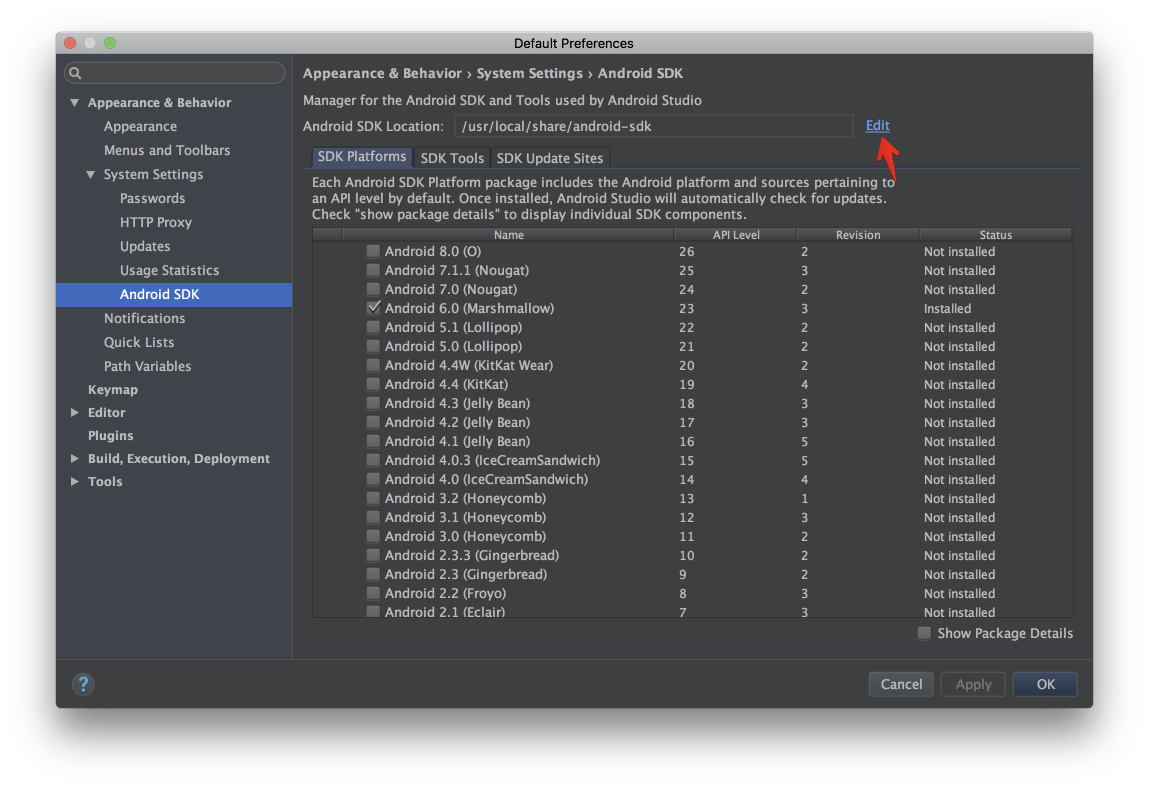

- #UPDATE DEVICE SDK FOR ANDROID STUDIO HOW TO#
- #UPDATE DEVICE SDK FOR ANDROID STUDIO FOR MAC#
- #UPDATE DEVICE SDK FOR ANDROID STUDIO INSTALL#
- #UPDATE DEVICE SDK FOR ANDROID STUDIO UPDATE#
- #UPDATE DEVICE SDK FOR ANDROID STUDIO WINDOWS#
For information about using the Android Emulator for testing and debugging, see Debugging on the Android Emulator. For information about using the Android Device Manager to create and manage virtual devices, see Managing Virtual Devices with the Android Device Manager. If you are using an emulator, create a virtual device for API level 29 and select an x86-based image. If you'd prefer to flash your device, please see the instructions on flashing a Factory Image or OTA Image to your device.
#UPDATE DEVICE SDK FOR ANDROID STUDIO UPDATE#
If you are using a physical device such as a Pixel, you can download the Android 10 update by going to the System > System update > Check for update in your phone's settings. For more information about configuring Android API levels, see Understanding Android API Levels. This includes both your Target Framework Version and Target Android SDK Version to API 29 or later.

For example, to target your project for Android 10, you must configure the target Android API level of your project to Android 10.0 (API 29). When you create an Android project, you must configure the version settings to target Android 10.0 or later. If you are new to Android development with Xamarin, see Hello, Android to learn about creating Xamarin.Android projects.

#UPDATE DEVICE SDK FOR ANDROID STUDIO INSTALL#
Install the Android 10 SDK Platform packages, which are listed as Android SDK Platform 29 in the Platforms tab (for more information about using the SDK Manager, see Android SDK setup):Ĭreate a new Xamarin.Android project. In the lower right-hand corner, click the gear icon and select Repository > Google (Unsupported): In Visual Studio for Mac, click Tools > SDK Manager. In Visual Studio, click Tools > Android > Android SDK Manager. To create a project with Xamarin.Android 10.0, you must first use the Android SDK Manager to install the SDK platform for Android 10 (API level 29).
#UPDATE DEVICE SDK FOR ANDROID STUDIO FOR MAC#
On macOS, update to Visual Studio 2019 for Mac 8.3 or later (for instructions, see Update Visual Studio 2019 for Mac to the most recent release). If you are using Visual Studio 2019, update to Visual Studio 2019 version 16.3 or later (for instructions, see Update Visual Studio 2019 to the most recent release). Visual Studio 2019 is recommended for building Android 10 apps using Xamarin.

#UPDATE DEVICE SDK FOR ANDROID STUDIO WINDOWS#
NET workload on Windows and installed as part of the Visual Studio for Mac Installer) Xamarin.Android - Xamarin.Android 10.0 or later must be installed with Visual Studio (Xamarin.Android is automatically installed as part of the Mobile Development With.On macOS, update to Visual Studio 2019 for Mac version 8.3 or later. On Windows update to Visual Studio 2019 version 16.3 or later. Visual Studio - Visual Studio 2019 is recommended.The following list is required to use Android 10 features in Xamarin-based apps: For more information about Xamarin.Android support for Android 10, see the Xamarin.Android 10.0 release notes. Xamarin.Android 10.0 provides support for Android 10.
#UPDATE DEVICE SDK FOR ANDROID STUDIO HOW TO#
It also provides an outline of the new features in Android 10 and provides example source code that illustrates how to use some of the key Android 10 features. It explains how to install the necessary updates, configure the SDK, and prepare an emulator or device for testing. This article is structured to help you get started in developing Xamarin.Android apps for Android 10. A number of new features and APIs are being made available in this release, and many of them are necessary to take advantage of new hardware capabilities in the latest Android devices. How to get started developing apps for Android 10 using Xamarin.Android.Īndroid 10 is now available from Google.


 0 kommentar(er)
0 kommentar(er)
